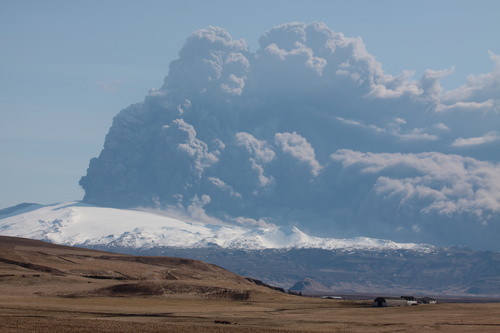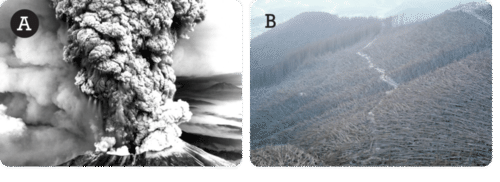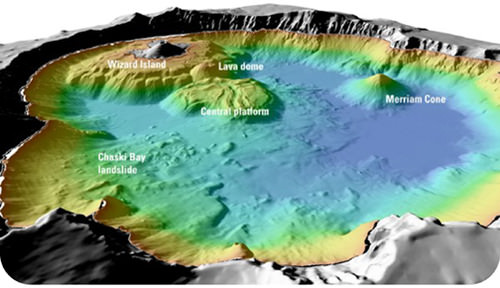7.5爆炸性喷发
Section outline
-
What would cause a giant explosion like this one?
::怎么会造成这么大的爆炸呢?The type of eruption a volcano has depends on the composition of the magma . Silica-rich, felsic magma can trap a lot of gas. So these magmas produce explosive eruptions. Silica-poor mafic magmas trap little gas. These magmas produce quiet eruptions. Which type of eruption do you think is safest to be near?
::火山爆发的类型取决于岩浆的构成。 富含硅石的、 丰盛的岩浆可以捕捉大量的气体。 因此这些岩浆会产生爆炸性爆发。 贫瘠的泥浆岩浆会捕捉小气体。 这些岩浆会产生静静的火山爆发。 你认为哪种喷发最安全?Eruptions
::燃烧All share the same basic features. First, mantle melts. The molten rock collects in magma chambers that can be 160 kilometers (100 miles) beneath the surface. As the rock heats, it expands. The hot rock is less dense than the surrounding rock. The magma rises toward the surface through cracks in the crust . A volcanic eruption occurs when the magma reaches the surface. Lava can reach the surface gently or explosively.
::都具有相同的基本特征。 首先, 地壳融化。 熔岩聚集在岩浆室中, 地表下可达160公里( 100英里) 。 随着岩石的热量增加, 它会膨胀。 热岩比周围岩石密度小。 岩浆通过地壳裂块向地表上升。 当岩浆到达地表时, 火山爆发会发生。 岩浆可以轻轻地或爆炸地到达地表 。Explosive Eruptions
::爆炸性爆炸An explosive eruption produces huge of volcanic ash. Chunks of the volcano fly high into the atmosphere . Explosive eruptions can be tens of thousands of times as powerful as an atomic bomb ( Figure ). Hot magma beneath the surface mixes with water . This forms gases. The gas pressure grows until it must be released. The volcano erupts in an enormous explosion.
::爆炸性火山爆发产生巨大的火山灰。火山的柱子高飞到大气中。爆炸性火山爆发的威力可能比原子弹(图)高几万倍(图)。地表下的热岩浆与水混合。这形成了气体。气体压力会增加,直到必须释放为止。火山爆发在巨大的爆炸中。Eyjafjallajökull volcano in Iceland spewed ash into the atmosphere in 2010. This was a fairly small eruption, but it disrupted air travel across Europe for six days.
::2010年冰岛的Eyjafjallajökull火山喷出灰灰尘进入大气,这是一个相当小的火山爆发,但干扰了欧洲各地六天的空中旅行。Ash and particles shoot many kilometers into the sky. The material may form a mushroom cloud, just like a nuclear explosion. Hot fragments of rock, called pyroclasts , fly up into the air at very high speeds. The pyroclasts cool in the atmosphere. Some ash may stay in the atmosphere for years. The ash may block out sunlight. This changes patterns and affects the of the Earth. For a year or two after a large eruption, sunsets may be especially beautiful worldwide.
::灰和粒子在天空中射出许多公里。 材料可能形成蘑菇云, 就像核爆炸一样。 岩石的热片, 叫做火花, 以非常高的速度飞到空气中。 火花在大气中冷却。 有些灰灰可能停留在大气中多年。 灰灰可能会阻隔阳光。 这会改变模式, 影响地球。 在大规模爆发后一两年, 日落可能在全世界特别美丽 。Volcanic gases can form poisonous, invisible clouds. The poisonous gases may be toxic close to the eruption. The gases may cause environmental problems like and ozone destruction.
::火山气体可形成有毒的、看不见的云,有毒气体在火山爆发附近可能有毒,可能引起环境问题,如破坏臭氧。Mt. St. Helens
::圣海伦山In 1980, Mount St. Helens, located between Portland, Oregon and Seattle, Washington, erupted explosively. The eruption killed 57 people, destroyed 250 homes, and swept away 47 bridges. The volcano blew off its top so that it lost over 400 meters (1,300 feet) of height. Mt. St. Helens is still active ( Figure ). Within the crater , a new lava dome formed.
::1980年,位于华盛顿波特兰、俄勒冈和西雅图之间的圣海伦斯山爆发了爆炸性爆炸,火山爆发造成57人死亡,250个房屋被毁,47座桥梁被扫走。火山顶部爆炸,致使其高度损失超过400米(1 300英尺)。圣海伦斯山仍然活跃(图 ) 。 在火山坑内形成了一座新的熔岩穹顶。(A) Mount St. Helens eruption on May 18, 1980. Mt. Adams is in the background on the right. (B) The eruption of Mt. St. Helens blew down acres of trees like they were toothpicks.
:A) 1980年5月18日圣海伦斯山爆发。亚当斯山位于右边的背景。 (B) 圣海伦斯山的爆发像牙签一样炸毁了英亩的树木。
Much of the damage in the eruption was due to pyroclastic flows. Pyroclastic flows of pyroclasts and ash knock down everything in their path. The temperature inside a pyroclastic flow may be as high as 1,000°C (1,800°F).
::火山爆发的破坏大部分是由火化流造成的,火化和火山灰的火化流粉碎了他们道路上的一切。 火化流中的温度可能高达1,000摄氏度(1,800摄氏度)。Lahars are mixtures of ash and water that travel down river valleys . On Mount St. Helens, the eruption melted . The water mixed with ash from the eruption and created tremendous lahars. The lahars raced down valleys and knocked out many bridges.
::拉哈德是沿河谷行进的灰和水的混合物。在圣海伦山上,火山喷发融化了。火山喷发产生的灰和水混合了火山灰,并产生了巨大的拉哈尔。拉哈尔人冲下山谷,打倒了许多桥梁。Mt St. Helens was not a very large eruption for the Cascades. Mt. Mazama blew itself apart in an eruption about 42 times more powerful than Mount St. Helens in 1980. Today all that remains of that huge stratovolcano is Crater Lake ( Figure and Figure ).
::马扎马山在1980年的火山爆发中爆炸,比圣海伦山的威力高出42倍。 今天,这个巨大的斯特拉托伏尔卡诺火山的残留物是克拉泽湖(图和图)。Crater Lake fills the caldera of the collapsed Mt. Mazama. The bathymetry of the lake shows volcanic features such as cinder cones.
::克拉特湖填满了倒塌的Mazama山的热量,湖水深显示火山特征,如煤灰锥。Crater Lake, located in Crater Lake National Park in southern Oregon.
::克拉特湖,位于俄勒冈南部克拉特湖国家公园。Summary
::摘要- Felsic magmas erupt explosively, creating pyroclastic eruptions.
::Felsic 岩浆爆炸性喷发 产生火化喷发
- Pyroclastic eruption types include tephra, ash, and lahars.
::烟火喷发类型包括tephra、Ash和lahars。
- Mt. Mazama blew its top off and then collapsed, creating Crater Lake in Oregon.
::Mt. Mazama山炸掉顶部,然后倒塌,在俄勒冈州建立了克拉特湖。
Review
::回顾- What is the role of water in an explosive eruption?
::水在爆炸性喷发中的作用是什么?
- Why do felsic magmas erupt explosively?
::为什么费利茨岩浆会爆炸性地喷发?
- How do volcanic gases affect the atmosphere?
::火山气体如何影响大气层?
- Felsic magmas erupt explosively, creating pyroclastic eruptions.




